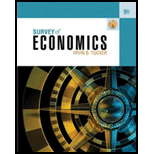
The meaning of scarcity.
Answer to Problem 1KC
Option 'e' is correct.
Explanation of Solution
Scarcity is obviously shortage. The shortage of supply to the existing
Option (e):
Human wants are unlimited, and there are no limits to the wants of the consumers. But the resources to meet human wants are limited, which means that there is scarcity of resources in the economy. The available scarce resources have many alternative uses that make choices for the consumers. Thus, scarcity forces the individuals to choose between the available choices. This indicates that option 'e' is correct.
Option (a):
Scarcity arises when the wants are more than the supply. This means when the supply of anything from money to goods and services are lower than the demand, there arises scarcity. Thus, when there is scarcity, not all the wants can be satisfied because the scarce resources have alternative uses. This makes option 'a' incorrect.
Option (b):
The consumers are free to choose between the alternative uses of the scarce resources and are not forced to accept one, which means that there is no abandoning of the consumer sovereignty. This means that option 'b' is also incorrect.
Option (c):
Scarcity arises when the wants are higher than the supply. The resources are having alternative uses and when the consumers lie about their wants, they cannot get the wants fulfilled, and this means that they would never lie about the wants, and so, option 'c' is incorrect.
Option (d):
The resources are limited, whereas the human wants are limited, and this makes scarcity in the economy. Thus, humans cannot make the unlimited resources because it is naturally formed. This means that option 'd' is incorrect.
Scarcity: The term “scarcity” defines the situation where the supply of something in the economy is lower than the required demand in the economy, which is obviously known as shortage.
Want to see more full solutions like this?
Chapter P1 Solutions
Survey of Economics (MindTap Course List)
- Suppose there is a new preventative treatment for a common disease. If you take the preventative treatment, it reduces the average amount of time you spend sick by 10%. The optimal combination of Z (home goods) and H (health goods). both may increase both may increase or one may stay the same while the other increases. both may decrease H may increase; Z may not change Z may increase; H may decreasearrow_forwardIn the Bismarck system,. may arise. neither selection both adverse and risk selection ☑ adverse selection risk selectionarrow_forwardPls fill out/explain to me these notes and explanations, thanksarrow_forward



